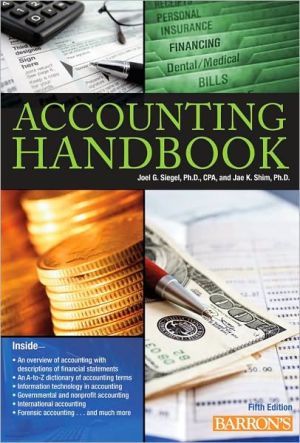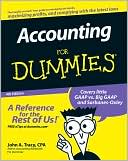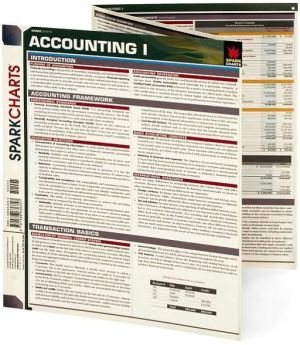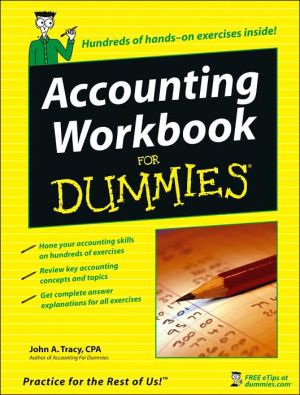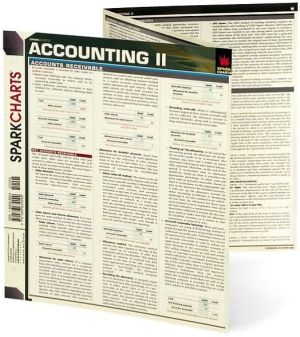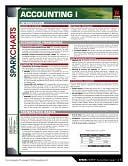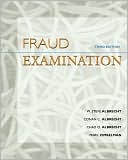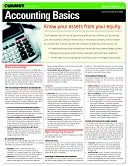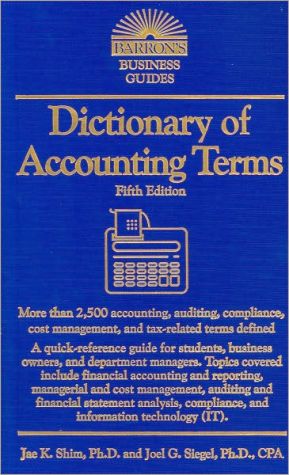Barron's Accounting Handbook
The newly updated edition of this authoritative reference volume deserves a place in the library of every accountant, bookkeeper, accounting manager, CPA, CFO, controller, business manager, and business student. An opening overview of financial accounting describes financial statements and presents details on financial reporting requirements and compliance, and USA GAAP (Generally Accepted Accounting Principles) and IFRS (International Financial Reporting Standards). Chapters that follow...
Search in google:
(back cover) The new fifth edition of Barron's Accounting Handbook presents a comprehensive overview of accounting principles and practices plus an A-to-Z dictionary of accounting terms. Here in one volume is an authoritative reference volume for accountants, bookkeepers, accounts managers, controllers, business managers, and business students. Filled with enlightening and instructive tables and diagrams. (front flap) The new fifth edition of this authoritative reference volume has been updated with an overview of information technology in accounting, as well as updated FASB (Financial Accounting Standards Board) and its Accounting Standards Codification (ASC), and IFRS (International Financial Reporting Standards). Other topics covered include a discussion of financial accounting that describes financial statements and presents details on financial reporting requirements and compliance, as well as detailed explanations of cost management and taxation forms and their preparation. An extensive A-to-Z dictionary of accounting terms follows, presenting short-entry definitions of everything from Abacus and Absorption Costing to Zero-Base Budgeting and Z Score. The book's concluding chapters explain quantitative methods for accounting, auditing, personal financial planning, governmental and nonprofit accounting, international accounting, and forensic accounting. Appendices cover recent accounting-related legislation, financial reporting differences among different countries, and more. Here is a reference book that deserves a place in the library of every accountant, bookkeeper, accounting manager, CPA, CFO, controller, business manager, and business student. (back flap) Joel G. Siegel, Ph.D., CPA, is a Professor of Accounting at Queens College in the City University of New York. Jae K. Shim, Ph.D., is Professor of Accounting, College of Business Administration, California State University, Long Beach.
Preface vii1 Financial Accounting: The Financial Statements 1Income Statement Reporting 1Balance Sheet 14Statement of Cash Flows 342 Financial Accounting: Financial Reporting Requirements 45Interim Reporting 45Hierarchy of GAAP 47FASB Accounting Standards Codification (ASC) 48Accounting Changes 49Prior Period Adjustments 51Disclosure of Accounting Policies 52Segmental Reporting 52Imputing Interest on Notes 54Business Combinations 55Consolidation 60Investments in Securities 64Fair Value Measurements 70Fair Value Option for Financial Assets and Financial Liabilities 72Leases 78Pension Plans 84Income Tax Accounting 95Foreign Currency Translation and Transactions 99Financial Instruments 102Related Parties 1063 Management Accounting/Cost Management I 107Introduction: The Role of Management Accounting 107Cost Accounting vs. Cost Management 108Part I Processing Cost Data for Cost Accumulation 116Cost Concepts, Terms, and Classifications 116Cost-Accumulation Systems 120Costing Joint Products and By-products 132Allocation of Service Department Costs to Production Departments 133Activity-Based Costing 136Activity-Based Management 140Just-in-Time (JIT) and Total Quality Management (TQM) 147Measuring Quality Costs 151Backflush Costing 154Throughput 154Environmental Costs and Ecoefficiency 157Life-Cycle Costs and Target Costing 161Part II Using Cost Data for Planning 166Cost Behavior Analysis-Analysis of Mixed Costs 166Cost-Volume-Profit (CVP) and Break-Even Analysis 177Absorption Versus Variable Costing 184Budgeting for Profit Planning 188A Shortcut Approach to Formulating the Budget 1994 Management Accounting/Cost Management II 201Part III Using Cost Data for Control 201Responsibility Accounting: Introduction 201Standard Costs and Variance Analysis for Cost Centers 202Segmental Reporting for Profit Centers 226Responsibility Accounting for Investment Centers 236Balanced Scorecard 242Transfer Pricing 244Part IV Using Cost Data for Decision Making 249Short-Term and Nonroutine Decisions 249Capital Budgeting Decisions 259How Does MACRS Affect Investment Decisions? 2685 Financial Statement Analysis 274Importance 274Horizontal Analysis 275Ratio Analysis 279Summary and Limitations of Ratio Analysis 2966 Individual Income Taxation: Preparation and Planning 308How to Postpone Taxes 308Sources of Tax-Exempt Income 309How to Delay Paying Tax on Interest 311Gains or Losses on Securities Transactions 312Tax Strategies When Children Are Involved 313Itemized Deductions 314Self-Employment 319Personal Exemptions 319Standard Deduction 320Tax Implications of Pension Plans 320Real Estate Transactions 322Gifts 323Determination of Tax 324Estate Planning 326Advantages of Having a Trust 328Alternative Minimum Tax 3297 Dictionary of Accounting Terms 3328 Information Technology in Accounting 778Accounting Packages 778Activity-Based Costing (ABC) Software 785Spreadsheets (Electronic Worksheets) 788Auditing Tasks 791Spreadsheet-Program-Assisted Auditing 794Tax Preparation and Planning 797Using Database Management Systems (DBMS) 798Software Systems That Impact Value Chain Management 799Wireless Technology 8009 Quantitative Methods for Accounting 816Decision Making 816Linear Programming and Shadow Pricing 821Learning Curve 827Inventory Planning 828Program Evaluation and Review Technique (PERT) 83510 Auditing and Internal Control Over Financial Reporting 841Sarbanes-Oxley Act and the Public Company Accounting Oversight Board (PCAOB) 841Audit Reports 843Compilation of Financial Statements 851Review of Financial Statements 853Reports on Prospective Financial Statements 855Audit Documentation 863Internal Auditing 863Section 404 of the Sarbanes-Oxley Act 865The Sox Section 302 and Section 906 Considerations 87511 Personal Financial Planning 882Objectives of Personal Financial Planning 88212 Governmental and Nonprofit Accounting 917Characteristics of Nonbusiness Organizations 917Governmental Accounting 919Nonprofit Organizations and Financial Reporting 95013 International Accounting and International Financial Reporting Standards (IFRS) 957Introduction: Accounting Dimensions of International Business 958Foreign Currency Exchange Rates 959U.S. GAAP vs. IFRS 968Required Financial Statements and Structural Differences in Primary Financial Reporting 969IFRS Differences Affecting the Statement of Financial Position 971IFRS Differences Affecting the Income Statement 97614 Forensic Accounting 980Why is Forensic Accounting Necessary? 981When Does One Employ a Forensic Accountant? 982Where Is a Forensic Accountant Used? 983How Does a Forensic Accountant Work? 984Forensic Accounting and Fraud Examination 985Forensic Specialists' Investigation Procedure 987Forensic Computing and the Use of Technology 988IT and Data Mining Used to Detect Corporate Fraud 989A Case in Forensic Accounting 990Appendices 1006Appendix A Summary of the Sarbanes-Oxley Act of 2002 1006Appendix B Sarbanes-Oxley Compliance Practice Aid 1018Index 1042
